Creating type conversion mappings
To create type conversion mappings, you use the i2 Analyze Server Admin Console.
In a web browser, navigate to the URI of a i2 Analyze development environment, but append /admin. For example: http://<host_name>:9082/opal/admin.
When you log in using credentials with the i2:Administrator:Connectors command access control permission, the i2 Analyze Server Admin Console appears. For more information about ensuring you have the correct permissions, see Enabling access to the Server Admin Console.
The mapping configuration interface
By default, the admin console displays the status of the i2 Connect gateway. To display the mapping configuration interface, select the i2 Analyze Type Conversion app, which is highlighted in red:
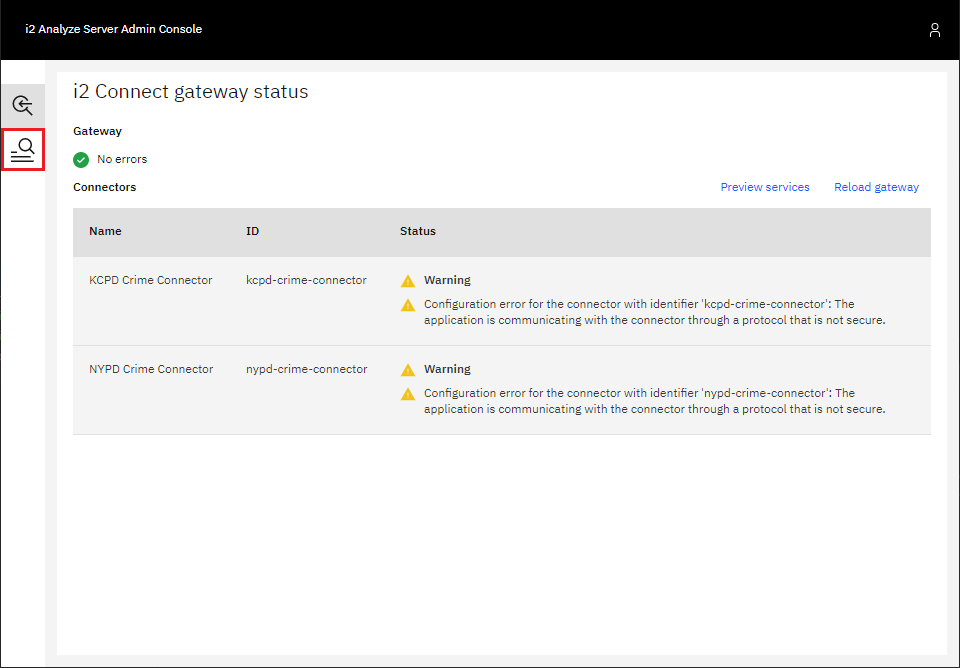
The console now displays a list of all the item types across all gateway and connector schemas, with some information about any item type mappings that have been defined. In this example, no mappings are configured yet.
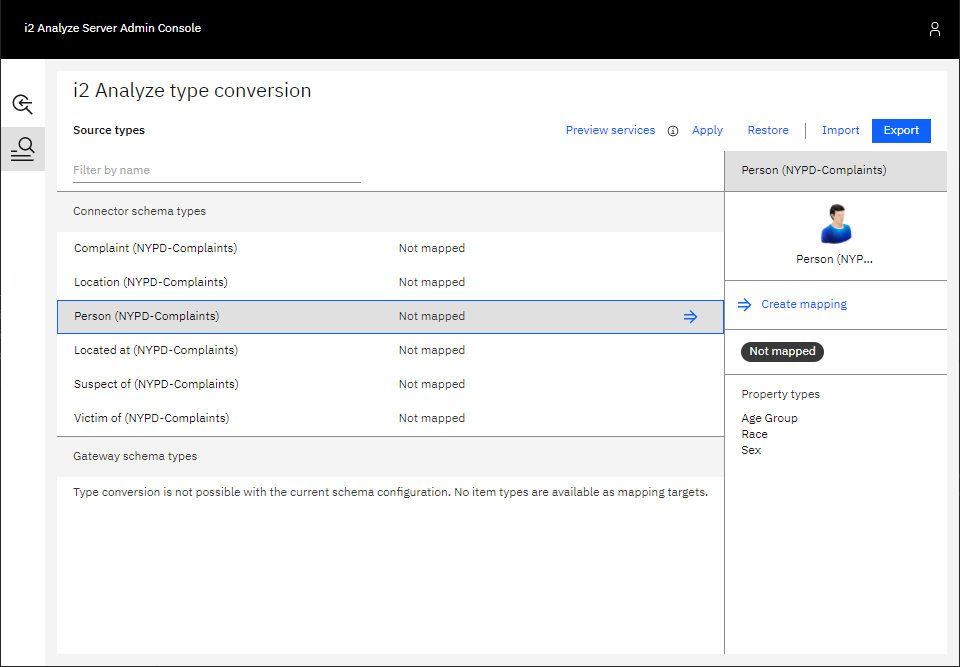
Defining a mapping
Note: The following description is based on types from the NYPD-Complaints and KCPD-Crime schemas that feature in examples in the analyze-connect repository.
The NYPD-Complaints and KCPD-Crime schemas both contain entity types named "Person". Both types define the same property types: age, sex, and race. But a significant difference is that the NYPD Person type models age in ranges, while the KCPD Person type holds specific values for ages.
NYPD Person | KCPD Person |
|---|---|
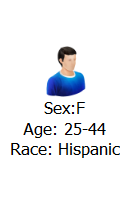 | 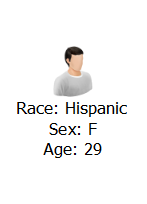 |
Select the source type.
In the list of item types, select the one to map from. For this example, the Person type from the NYPD-Complaints connector schema is selected. Then, click on either the arrow shown on the list item, or Create mapping in the pane on the right.
Select the target type.
The app now displays a dialog box that contains a list of item types to which your selected source type can be mapped. Choose an appropriate item type. For this example, the Person type from the KCPD-Complaints gateway schema is selected. After you select the target type, click Create mapping.
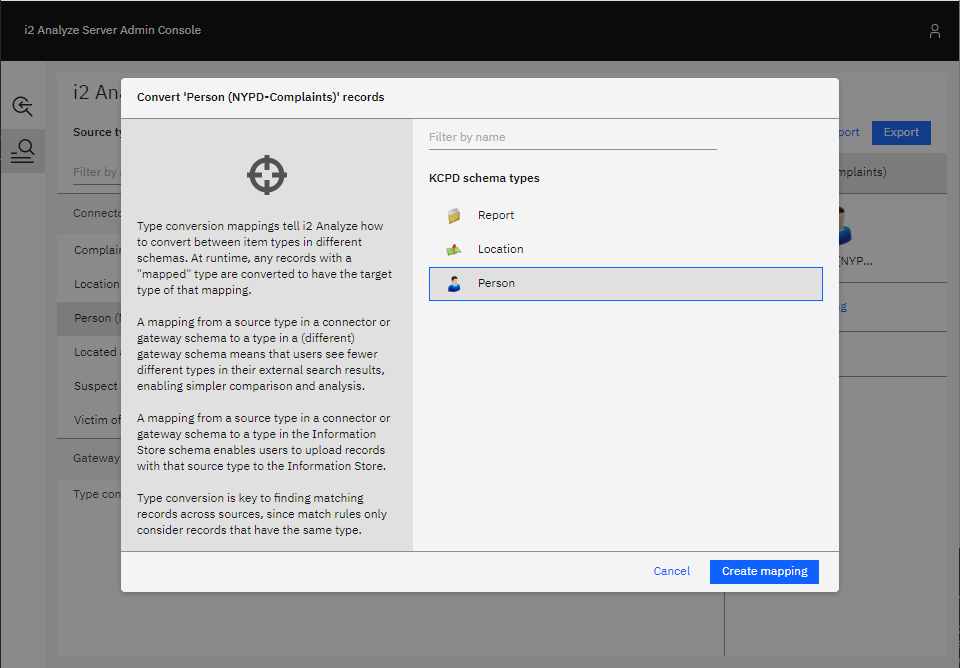
Define the property mappings.
At this stage, define how the property values of the source type are mapped to property values of the target type.

The properties shown in the dialog are the properties of the target type. For each target property, you can do one of the following:
Map a property from the source item type to the target property. When a record of the source item type is converted to a record of the target item type, the target property is populated with the value of the source property. The logical type of the source property type must be compatible with the logical type of the target property type.
Map to a fixed value. When a record of the source item type is converted to a record of the target item type, the target property is populated with the fixed value provided in the mapping configuration.
Leave the property unmapped. When a record of the source item type is converted to a record of the target type, the target property is not populated. Target property types that are mandatory cannot be left unmapped.
Automatically mapped properties
A property type in the source item type is automatically mapped to a property type in the target item type if they have the same:
Display name
Logical type
If the two properties have the logical type SELECTED_FROM or SUGGESTED_FROM, any possible values of the source property that are also present in the target property are mapped automatically to those values in the target property.
You can see in the example that this logic was applied to the race and sex property types. These automatically generated mappings can still be edited if they do not meet your requirements.
Mapping a property from the source item type
To map a property from the source item type to a target property:
Select Property value in the left-most dropdown menu below the target property name.
Choose a property from the source item type in the right-most dropdown. Only compatible properties from the source type are shown.
For all logical types except SELECTED_FROM and SUGGESTED_FROM, these are the only required steps. For properties with a logical type of SELECTED_FROM or SUGGESTED_FROM, you might also need to specify how the values are mapped.
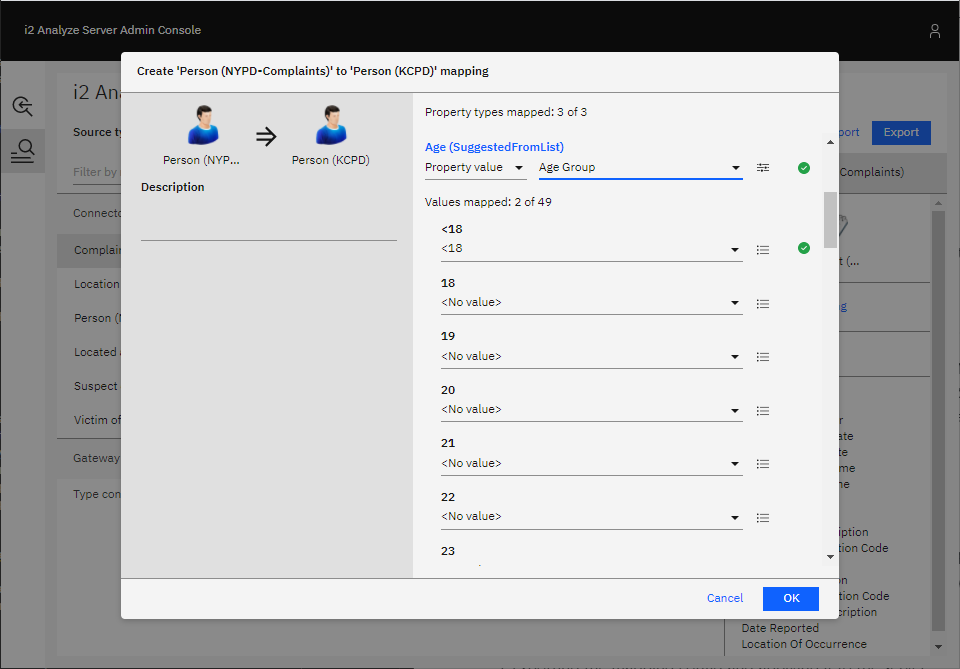
Value mapping is necessary in this example, for the mapping of the age group property in the NYPD schema to the age property in the KCPD schema. The source age group property is a SUGGESTED_FROM list of age groups; the target age property is a SUGGESTED_FROM list of specific ages.
The values in the dialog box are the possible values for the target age property. For each target value, you can do one of the following:
Map a value from the source property to it. Select which value of the source property is to be mapped to the target value. You cannot map a single value from the source property to more than one value of the target property.
Leave it unmapped. Select <No value> in the dropdown. Then, no value from the source property type is mapped to this value of the target property.
Similar to how property types are automatically mapped, values of SELECTED_FROM and SUGGESTED_FROM properties are automatically mapped if the value of the target property type is the same as a value of the source property type. This is the case here for the "<18" and "65+" values.
For the other target values, you must either choose an age group from the source value to effectively collapse to a single age, or leave them unmapped.
Mapping a fixed value
To map a fixed value to a target property:
Select Fixed value in the left-most dropdown menu below the target property name.
Enter a fixed value to use in the left-most field.
Choosing a value for reverse conversions
If a connector accepts a particular item type for the seeds of a seeded search, and that item type is the source type of a mapping, then users can use records of the mapping's target type as seeds when using the service.
When i2 Analyze sends these seed records to the connector, it must apply the mapping in reverse. The connector is expecting seeds of the source item type, and it is unaware of any mapping configured on the i2 Analyze server.
For mappings of properties where the logical type of both the source property and the target property are the same (and are not SELECTED_FROM or SUGGESTED_FROM), the reverse conversion just involves populating the source property with the value of the target property.
For mappings between SELECTED_FROM and SUGGESTED_FROM properties, you can choose how i2 Analyze maps the values of the target property to the possible values of the source property:
Click the button to the right of the dropdown menu for a target value that has been mapped
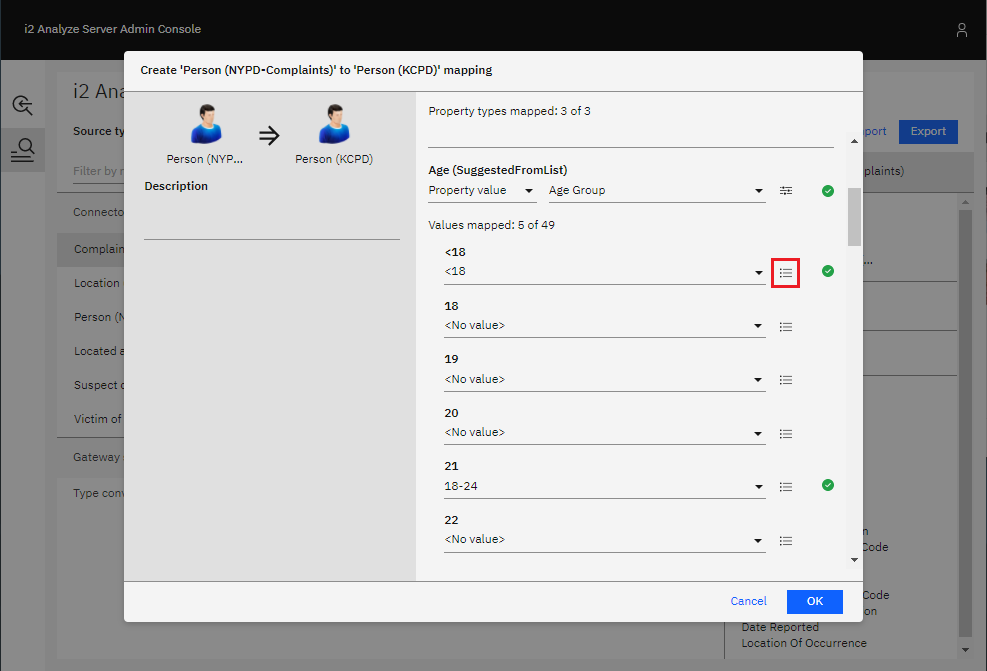
From the dropdown, select which one of the source values that you have mapped to the target value i2 Analyze should use when applying the mapping in reverse for seeded searches.
Confirm your choice by clicking OK.
Add a description.
After you define the property mappings, you can add a description of the item type mapping.
Confirm the mapping.
Click OK in the bottom-right of the dialog to save your item type mapping. The list of item types shows how the source type has been mapped.
Note: At this point your mapping is not deployed on the server.
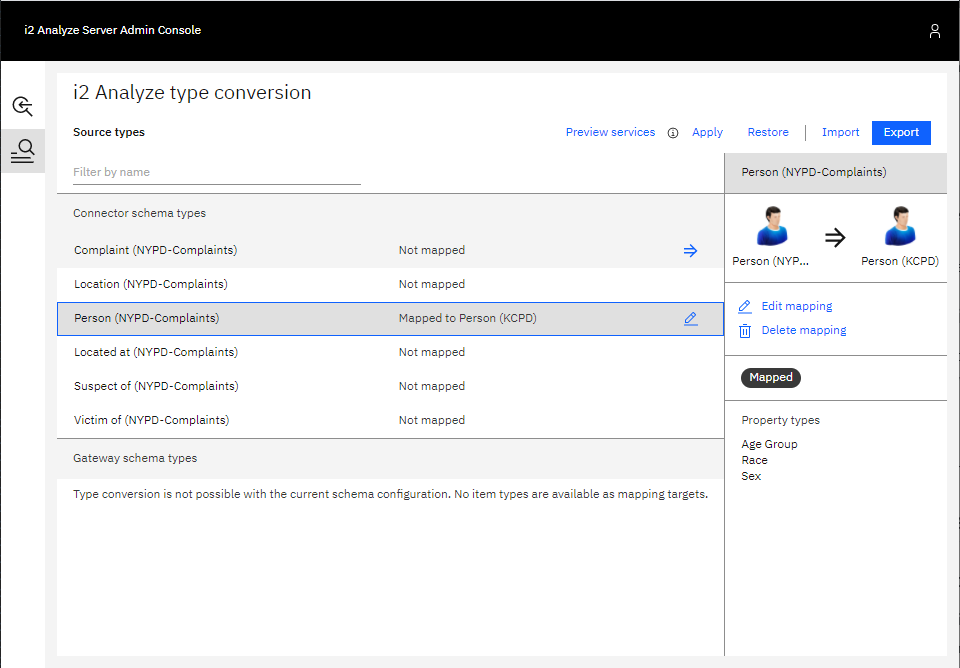
You can edit the mapping by clicking Edit mapping in the right-hand pane, or delete it by clicking Delete mapping.
Applying the mappings for testing
After you define the item type mappings, you can test the i2 Connect services in your i2 Analyze deployment to see how they would look if you were to apply the mappings you have configured. To do this:
Click Apply. This applies the current mapping configuration for testing.
Click Preview services. This opens the External Searches dialog as it would appear in Analyst's Notebook. You can use the services and see the results as they would appear if the mapping that has been applied for testing was deployed on the server.

To revert the mapping configuration back to the current deployed configuration on the server, you can also use the Restore button that is next to Apply.
Important: Property mappings can affect the behavior of i2 Connect services that support seeds with semantic constraints. Try to ensure that the target property types in your mappings have the same semantic types as (or child semantic types of) the source property types.
Applying the mapping to the server
After you preview the i2 Connect services using your new mappings and you are happy with them, you can deploy your mapping configuration to the i2 Analyze server. To do this:
In the mapping configuration interface, click Export in the top right corner. This downloads a mapping-configuration.json file.
Move the mapping-configuration.json file into the toolkit/configuration/fragments/common/WEB-INF/classes directory of your configuration.
Redeploy the i2 Analyze server:
setup -t stopLiberty setup -t deployLiberty setup -t startLiberty
